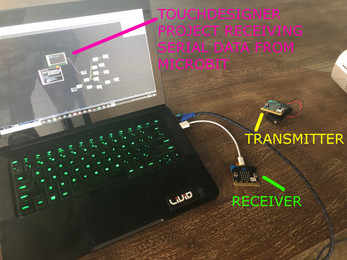Wait Shake!
A downloadable Interaction
Do you get bored without constant exposure to external stimuli? Do you hate waiting in lines at trade shows, industry conferences, the DMV, or the free clinic? Well despair no more, oh ye of little patience - introducing the Wait Shake!
The Wait Shake! is a device that puts the "fun" in "fundamentally poor event layout design"! The small handheld controller acts as a transmitter, sending acceleration data to a receiver connected to a dynamic image displayed on large video monitors or projected onto a wall. Guests pick up the controller, give it a shake, and watch the accompanying image change right before their eyes! Waiting has never been so interactive!
Wait Shake! uses two micro:bit controllers to send acceleration data over radio waves from the transmitter to the receiver. The receiver then sends that data into TouchDesigner via serial port, which is translated into a channel data stream that can be used to drive all sorts of things: color changes, image and object placement, and even real-time generative effects!
Built with:
- micro:bit microcontrollers
- TouchDesigner 088
- Javascript
- Python
Transmitter: https://makecode.microbit.org/_Ax9fYkDCicLk
| Status | Released |
| Author | BenParisot |
Download
Install instructions
- Download microbit-swReceiverFINAL.hex, microbit-swTransmitterFINAL.hex, and Wait Shake.zip.
- Plug a microbit controller into your computer via USB.
- Copy the TransmitterFINAL hex file into your microbit device folder. Once copied, eject that device and unplug the microbit. Label it as TRANSMITTER.
- Plug in a second microbit controller into your computer via USB.
- Copy the ReceiverFINAL hex file into your microbit device folder. Leave this device plugged into your computer.
- Open the Wait Shake.zip file and double click on microbitProject_FINAL.toe to open the project in TouchDesigner.
- Find the transmitter container and double click to enter it. Find the serial DAT operator.
- Make sure the serial parameters are set to:
- Active: ON
- Row/Callback Format: One per line
- Port: com6 (confirm this is the port your microbit is sending data across)
- Baud rate: 115200
- Data bits: 8
- Parity: None
- Stop Bits: 1
- DRT: Enable
- RTS: Disable
- Shake the controller. You should now see data stream in the Serial DAT affecting the image in the main final op (null2)!
